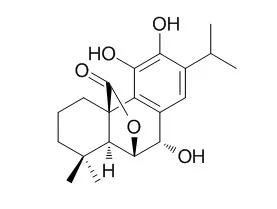| Kinase Assay: |
| Bioorg Med Chem. 2013 May 1;21(9):2618-22. | | Structure activity relationship of phenolic diterpenes from Salvia officinalis as activators of the nuclear factor E2-related factor 2 pathway.[Pubmed: 23507152] | Nuclear factor E2-related factor 2 (Nrf2) is a transcription factor known to activate cytoprotective genes which may be useful in the treatment of neurodegenerative disease.
METHODS AND RESULTS:
In order to better understand the structure activity relationship of phenolic diterpenes from Salvia officinalis L., we isolated carnosic acid, carnosol, epiRosmanol, Rosmanol, 12-methoxy-carnosic acid, sageone, and carnosaldehyde using polyamide column, centrifugal partition chromatography, and semi-preparative high performance liquid chromatography. Isolated compounds were screened in vitro for their ability to active the Nrf2 and general cellular toxicity using mouse primary cortical cultures.
CONCLUSIONS:
All compounds except 12-methoxy-carnosic acid were able to activate the antioxidant response element. Furthermore both carnosol and carnoasldehyde were able to induce Nrf2-dependent gene expression as well as protect mouse primary cortical neuronal cultures from H(2)O(2) induced cell death. | | Food Chem Toxicol. 2011 Feb;49(2):485-93. | | Rosmanol potently induces apoptosis through both the mitochondrial apoptotic pathway and death receptor pathway in human colon adenocarcinoma COLO 205 cells.[Pubmed: 21112365 ] | Rosemary (Rosmarinus officinalis), a culinary spice and medicinal herb, has been widely used in European folk medicine to treat numerous ailments. Many studies have shown that rosemary extracts play important roles in anti-inflammation, anti-tumor, and anti-proliferation in various in vitro and in vivo settings. The roles of tumor suppression of rosemary have been attributed to the major components, including carnosic acid, carnosol, and rosmarinic acid, Rosmanol, and ursolic acid. This study was to explore the effect of Rosmanol on the growth of COLO 205 human colorectal adenocarcinoma cells and to delineate the underlying mechanisms.
METHODS AND RESULTS:
When treated with 50 μM of Rosmanol for 24h, COLO 205 cells displayed a strong apoptosis-inducing response with a 51% apoptotic ratio (IC(50) ~42 μM). Rosmanol increased the expression of Fas and FasL, led to the cleavage and activation of pro-caspase-8 and Bid, and mobilized Bax from cytosol into mitochondria. The mutual activation between tBid and Bad decreased the mitochondrial membrane potential and released cytochrome c and apoptosis-inducing factor (AIF) to cytosol. In turn, cytochrome c induced the processing of pro-caspase-9 and pro-caspase-3, followed by the cleavage of poly-(ADP-ribose) polymerase (PARP) and DNA fragmentation factor (DFF-45).
CONCLUSIONS:
These results demonstrate that the Rosmanol-induced apoptosis in COLO 205 cells is involvement of caspase activation and involving complicated regulation of both the mitochondrial apoptotic pathway and death receptor pathway. | | J Agric Food Chem. 2009 Nov 25;57(22):10990-8. | | Rosmanol potently inhibits lipopolysaccharide-induced iNOS and COX-2 expression through downregulating MAPK, NF-kappaB, STAT3 and C/EBP signaling pathways.[Pubmed: 19856917] | Rosmanol is a natural polyphenol from the herb rosemary (Rosmarinus officinalis L.) with high antioxidant activity. In this study, we investigated the inhibitory effects of Rosmanol on the induction of NO synthase (NOS) and COX-2 in RAW 264.7 cells induced by lipopolysaccharide (LPS).
METHODS AND RESULTS:
Rosmanol markedly inhibited LPS-stimulated iNOS and COX-2 protein and gene expression, as well as the downstream products, NO and PGE2. Treatment with Rosmanol also reduced translocation of the nuclear factor-kappaB (NF-kappaB) subunits by prevention of the degradation and phosphorylation of inhibitor kappaB (IkappaB). Western blot analysis showed that Rosmanol significantly inhibited translocation and phosphorylation of NF-kappaB, signal transducer and activator of transcription-3 (STAT3), and the protein expression of C/EBPbeta and C/EBPdelta. We also found that Rosmanol suppressed LPS-induced phosphorylation of ERK1/2, p38 mitogen-activated protein kinase (MAPK) and phosphatidylinositol 3-kinase (PI3K)/Akt signaling.
Our results demonstrate that Rosmanol downregulates inflammatory iNOS and COX-2 gene expression by inhibiting the activation of NF-kappaB and STAT3 through interfering with the activation of PI3K/Akt and MAPK signaling.
CONCLUSIONS:
Taken together, Rosmanol might contribute to the potent anti-inflammatory effect of rosemary and may have potential to be developed into an effective anti-inflammatory agent. |
|
| Cell Research: |
| Anticancer Res. 2012 Nov;32(11):4781-9. | | Phenolic diterpenes derived from Hyptis incana induce apoptosis and G(2)/M arrest of neuroblastoma cells.[Pubmed: 23155243] | Neuroblastoma is one of the most commonly encountered solid tumors in the pediatric age group, and the prognosis of patients with advanced neuroblastoma is very poor.
In this study, the antitumor effects of five phenolic diterpenes derived from Hyptis incana (Lamiaceae), a Brazilian medicinal plant, were examined on neuroblastoma cells.
METHODS AND RESULTS:
Cytotoxicity was assessed by the 3-(4,5-dimethylthiazol-2-yl)-2,5-diphenyltetrazolium bromide (MTT) assay. Apoptotic nuclear shrinkage was monitored by Hoechst 33342 staining. The cell-cycle status was evaluated by flow cytometry and protein alterations were monitored by western blotting. Differentiated cells were photographed and counted in a randomized fashion. All of the examined compounds exhibited significant cytotoxicity towards the neuroblastoma cells. In particular, 7-ethoxyRosmanol had a high degree of efficacy. Nuclear condensation and degradation of procaspase-3 and -9 were observed after treatment of the cells with these compounds. Moreover, phenolic diterpenes induced cell-cycle arrest in the G(2)/M phase. Rosmanol and epiRosmanol tended to induce differentiation.
CONCLUSIONS:
Phenolic diterpenes isolated from H. incana have multiple antitumor effects on neuroblastoma cells. |
|






 Cell. 2018 Jan 11;172(1-2):249-261.e12. doi: 10.1016/j.cell.2017.12.019.IF=36.216(2019)
Cell. 2018 Jan 11;172(1-2):249-261.e12. doi: 10.1016/j.cell.2017.12.019.IF=36.216(2019) Cell Metab. 2020 Mar 3;31(3):534-548.e5. doi: 10.1016/j.cmet.2020.01.002.IF=22.415(2019)
Cell Metab. 2020 Mar 3;31(3):534-548.e5. doi: 10.1016/j.cmet.2020.01.002.IF=22.415(2019) Mol Cell. 2017 Nov 16;68(4):673-685.e6. doi: 10.1016/j.molcel.2017.10.022.IF=14.548(2019)
Mol Cell. 2017 Nov 16;68(4):673-685.e6. doi: 10.1016/j.molcel.2017.10.022.IF=14.548(2019)